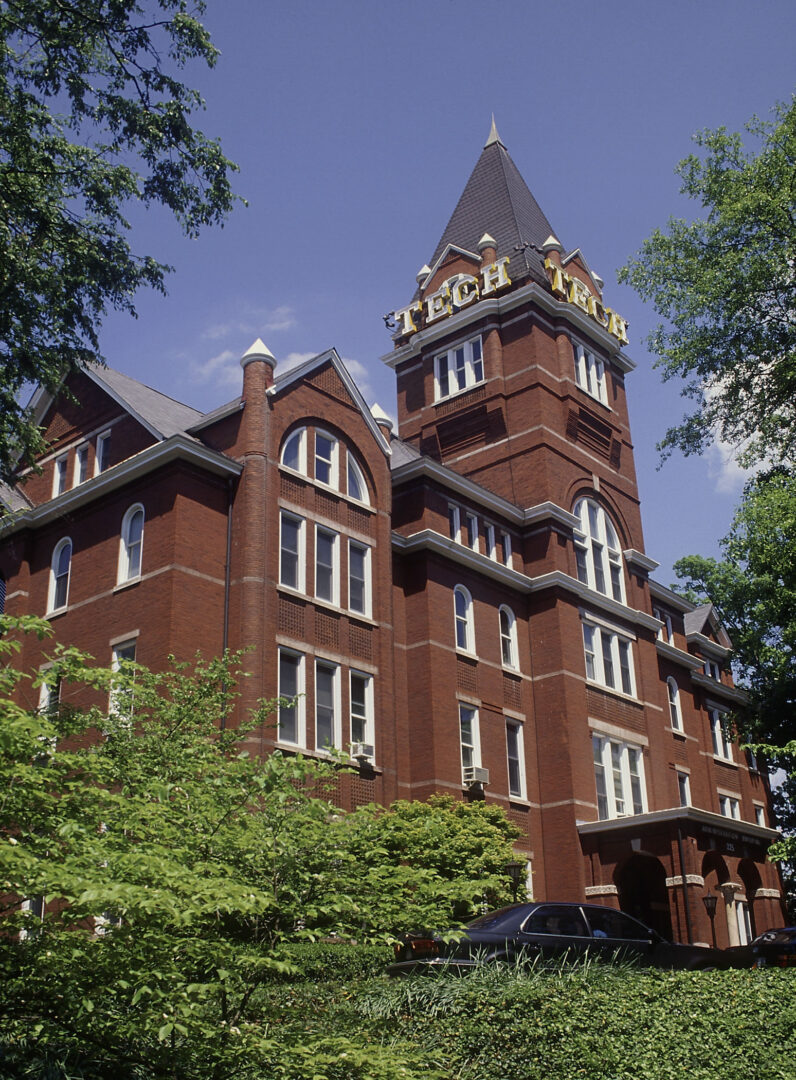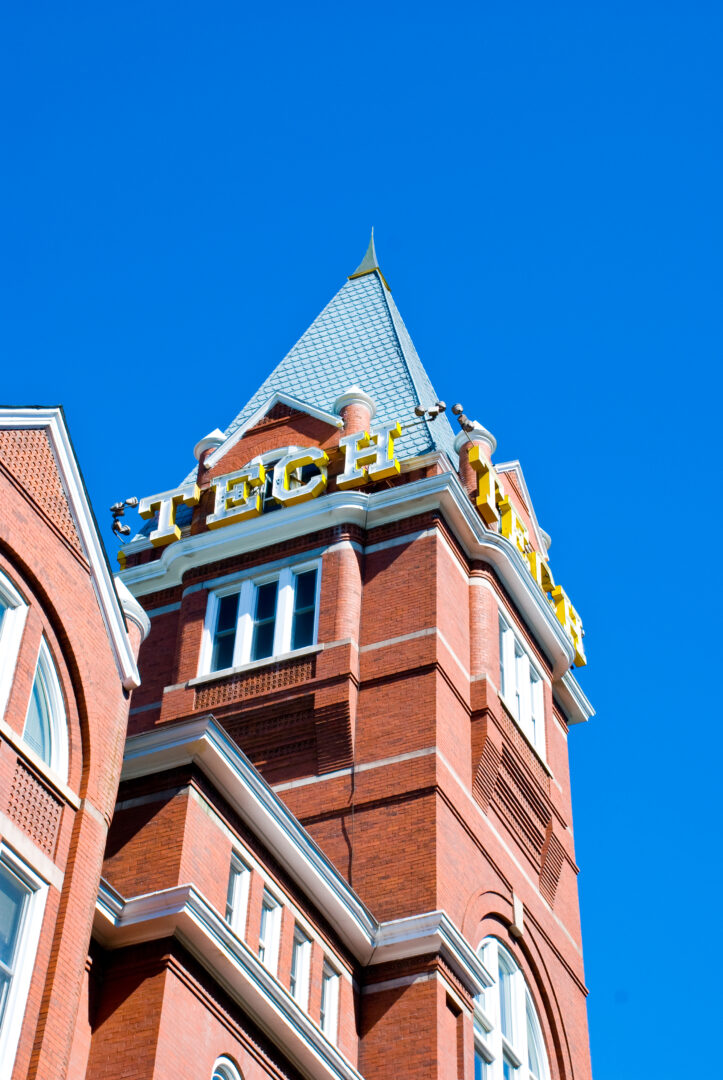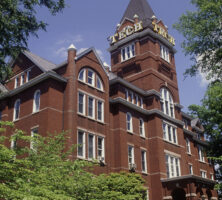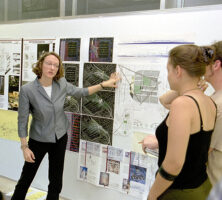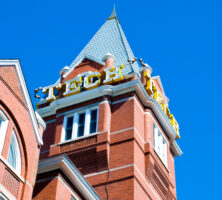The Georgia Institute of Technology, also known as Georgia Tech, is one of the nation’s top technological universities, distinguished by its commitment to improving the human condition through advanced science and technology. Founded in 1885 to help the state move beyond its agrarian roots, Georgia Tech today provides a broad technological education to more than 16,000 undergraduate and graduate students and conducts a $300 million-per-year research program on the cutting edge of engineering, the sciences, computing, and many other disciplines. The school is part of the University System of Georgia.
The Georgia Tech campus occupies 450 acres in the heart of Atlanta, where in fall 2003 more than 800 full-time academic faculty members taught in six colleges. More than 2,800 research faculty and other professionals conduct research and provide technology-based economic development assistance to help advance the state’s economy. In all, Georgia Tech is one of Atlanta’s largest employers, with more than 4,900 faculty and staff. Beyond the Atlanta campus, Georgia Tech also operates programs in Savannah and internationally, in France and Singapore.
History
Founded in October 1885 with an appropriation of $65,000 in state funds, Georgia Tech opened its doors in October 1888 as the Georgia School of Technology. The initial class of 129 students studied the basics of mechanical engineering. During its first fifty years, Georgia Tech grew from a narrowly focused trade school into a regionally recognized technological university.
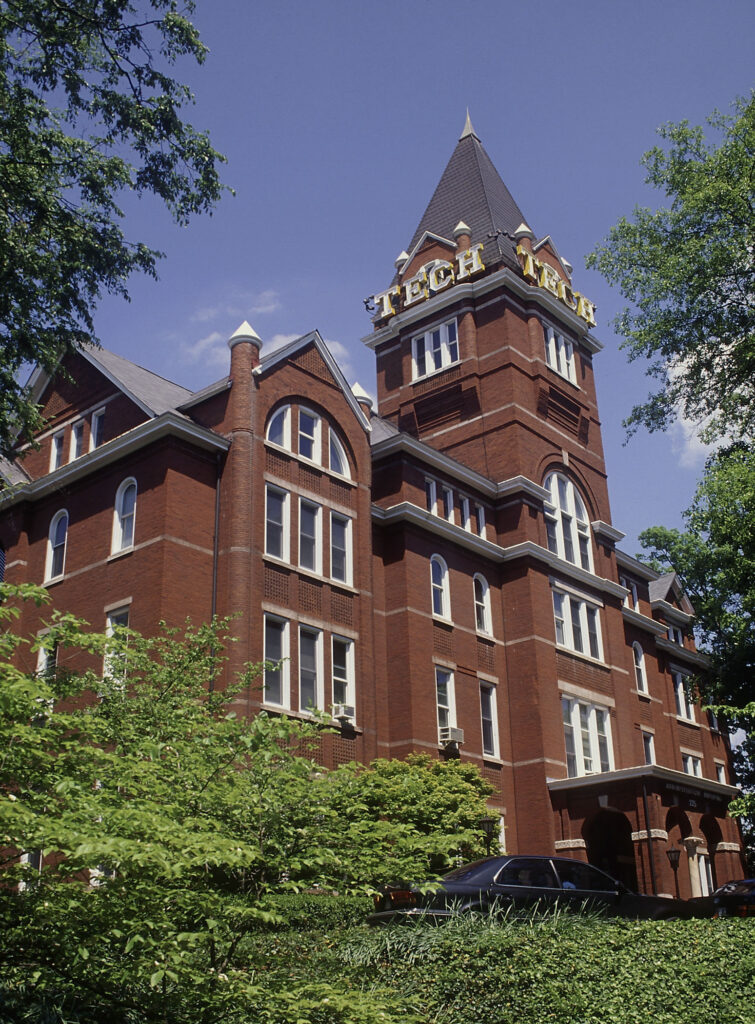
Courtesy of Georgia Tech Communications
In 1906 philanthropist Andrew Carnegie donated $20,000 to build Tech’s first library. The early years of the twentieth century also saw the introduction of the yearbook, the Blueprint (1908); the first publication of the student newspaper, the Technique (1911); and the beginning of the Co-op Program (1912), which allows students to gain career-related experience while earning a degree. Degree programs in civil, electrical, chemical, and textile engineering were added during Georgia Tech’s first thirty years, and the legendary John Heisman became the school’s first full-time football coach in 1903.
The School of Commerce, forerunner of the College of Management, was established in 1912. In 1919 the Georgia General Assembly authorized creation of the Engineering Experiment Station, planting the seeds for Georgia Tech’s future research and industrial extension programs.
During the presidency of Marion Luther Brittain (1922-44), Georgia Tech’s College of Architecture became the first southern school admitted to the Association of Collegiate Schools of Architecture (1926), and Georgia Tech obtained accreditation from the Southern Association of College and Secondary Schools (1930).
Reflecting a broadening curriculum and growing focus on science and advanced technology, the school’s name was changed to the Georgia Institute of Technology in 1948. The postwar era marked the beginning of Georgia Tech’s transformation from a regional engineering college to a nationally and internationally recognized technological university. During this period, encompassing the presidency of Blake Ragsdale Van Leer (1944-56), Georgia Tech began offering an engineering doctoral program. Women students were admitted for the first time in 1952, and in 1961 Georgia Tech became the first major state university in the Deep South to admit African American students without a court order.
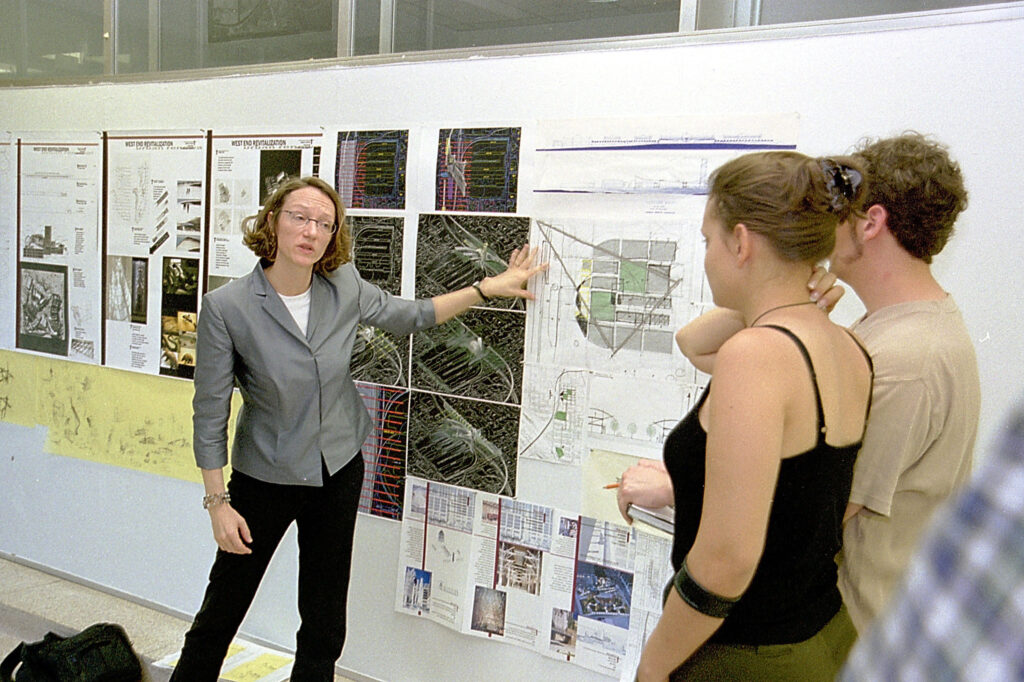
Courtesy of Georgia Tech Communications
In the 1970s, 1980s, and 1990s, under the leadership of Presidents Joseph M. Pettit (1972-86) and John P. Crecine (1987-94), Georgia Tech grew in stature nationally and internationally, broadening course offerings through a new College of Computing and the Ivan Allen College of Liberal Arts (named for Atlanta mayor Ivan Allen Jr.), dramatically expanding its research program, and embarking on an ambitious initiative to increase the number of masters and doctoral degrees granted.
In 1994 G. Wayne Clough became Georgia Tech’s tenth president, the first alumnus to hold that position. During Clough’s tenure a portion of Georgia Tech’s campus served as the Olympic Village for the 1996 Olympic Games and accelerated expansion into the new fields of biosciences and bioengineering. Georgia Tech’s five-year capital campaign raised more than $700 million, putting the institution on a course for a massive building campaign to support its growth in academic, research, and service endeavors.
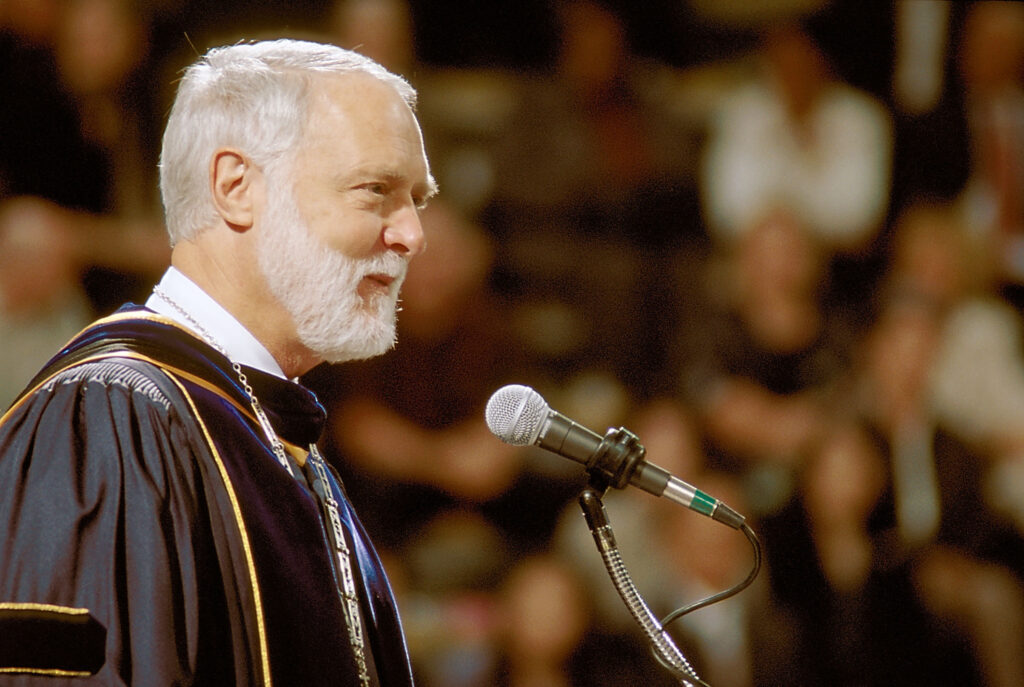
Courtesy of Georgia Tech Communications
In 1999 Georgia Tech’s engineering program was extended to students in southeast Georgia through the Georgia Tech Regional Engineering Program, based in Savannah and offered through regional and state universities in the area. In 2000 Georgia Tech and neighboring Emory University announced a joint Ph.D. program in biomedical engineering, providing recognition for their increasingly productive collaboration between medicine and engineering and setting the stage for future growth in biosciences and bioengineering. In 2005 the program was designated a national Center of Cancer Nanotechnology Excellence, one of only seven in the country, and received a federal grant for $20 million to study the application of nanotechnology to cancer treatment. (The university discontinued the undergraduate engineering program in 2012 because of funding pressures.)
Clough’s legacy will include construction of the Life Sciences and Technology Complex, an interdisciplinary complex housing biosciences and environmental sciences, and the Technology Square campus extension, a complex of buildings in midtown Atlanta. Along with the new construction, Georgia Tech has also preserved its historic campus, renovating for the School of Psychology the J. S. Coon Building, which once housed the School of Mechanical Engineering.
Curriculum and Campus Life
Georgia Tech offers more than 100 graduate and undergraduate degree programs, ranging from aerospace engineering and applied biology to statistics and textile engineering. Degrees are offered in the College of Architecture, College of Computing, Dupree College of Management, College of Engineering, Ivan Allen College of Liberal Arts, and College of Sciences. Georgia Tech has long been known for engineering programs that produce students ready to make contributions to industry and government, and its national reputation has been rising in the nonengineering disciplines.

Courtesy of Georgia Tech Communications
In the College of Architecture, Georgia Tech offers programs in traditional architecture, building construction, city and regional planning, and industrial design. In the College of Engineering, Georgia Tech offers aerospace engineering, biomedical engineering, chemical and biomolecular engineering, civil and environmental engineering, electrical and computer engineering, industrial and systems engineering, materials science and engineering, mechanical engineering, and polymer, textile, and fiber engineering.
The Ivan Allen College of Liberal Arts, Georgia Tech’s newest college, includes programs in economics; history, technology and society; international affairs; literature, communication, and culture; modern languages; and public policy. The College of Sciences includes applied physiology, biology, chemistry and biochemistry, earth and atmospheric sciences, mathematics, physics, and psychology.
Georgia Tech enrolled a record 16,643 students in fall 2003, including 11,257 undergraduates and 5,386 graduate students. The 2003 freshman class averaged 1336 on the SAT, one of the highest class averages among public universities in the United States. In 2003 the annual U.S. News and World Report magazine rankings of colleges and universities placed Georgia Tech ninth among all public universities, and the College of Engineering moved into the top five listing in its category. Minorities make up more than a third of Georgia Tech’s student body, contributing to high rankings in the education of Hispanic and African American engineers. Black Issues in Higher Education has named Georgia Tech the top producer of African American engineers in the United States.

Courtesy of Georgia Tech Communications
In 2002 Georgia Tech conferred 3,532 degrees, 52 percent of them to Georgia residents. The College of Engineering continues to be the overwhelming choice of students, conferring 2,111 degrees in 2002, nearly 60 percent of all those granted. Next in the number of degrees granted were the Dupree College of Management (436), College of Computing (315), College of Sciences (276), College of Architecture (216), and Ivan Allen College of Liberal Arts (178).
Since 1912 Georgia Tech has offered a five-year cooperative program to students who wish to combine career-related experience with classroom studies. The program is the fourth oldest of its kind in the world, and the largest totally optional co-op program in the country. Students who enroll in this program alternate semesters between industrial assignments and classroom studies, completing the same course work as regular four-year students. In 2002, 2,957 students participated in the undergraduate co-op program, and another 415 participated in the graduate co-op program, the largest such program in the United States for science and engineering.
Georgia Tech provides an extensive program of career counseling and assistance, attracting employers from across the country to interview its graduates. Tech increasingly involves its undergraduate students in opportunities to participate in sponsored research, with 1,350 students contributing to research activities in 2002. Nearly 750 Georgia Tech students in the 2002-3 school year took advantage of the opportunity to study abroad.
Georgia Tech’s Library and Information Center houses collections of scientific and technical information, as well as other scholarly resources. In all, the facility houses more than 3.9 million volumes, 2.7 million technical reports, and more than 1.3 million government documents. The library has access to more than 3,600 electronic journals, 200 databases of citations, abstracts, and full-text and numeric data.
In 2003 Georgia Tech’s faculty included twenty-four members of the National Academy of Engineering and three members of the National Academy of Sciences. As of 2003 faculty members have earned 83 National Science Foundation CAREER Awards, which honor the most promising young talent in science and engineering. And in 2003 four Georgia Tech faculty members were elected to membership in the American Association for the Advancement of Science.
Georgia Tech is rich in traditions. Buzz, its Yellow Jacket mascot, encourages fans at sporting events and turns up at a surprising number of campus functions. The Georgia Tech fight song celebrates the “Ramblin Wreck,” symbolized by a painstakingly restored yellow-and-gold 1930 Ford Model A that leads the football team onto the field at home games. The Georgia Tech Athletic Association is a nonprofit organization responsible for maintaining Tech’s intercollegiate athletic programs. Georgia Tech has won national football championships in 1917, 1928, 1952, and 1990. The Heisman Trophy is named for Georgia Tech’s first full-time football coach, John Heisman. Georgia Tech teams today participate in the Atlantic Coast Conference.

Image from brookenovak
The Georgia Tech Alumni Association was chartered in 1908 with the mission of promoting the institute, and today serves more than 100,000 Georgia Tech alumni. The association publishes a printed magazine and newspaper, in addition to an online newsletter. It maintains a unique “Living History” archive containing video interviews with more than 400 alumni, faculty, staff, and friends.
Research
Ranked thirtieth in the nation by the National Science Foundation (NSF) for the total volume of research ($306 million in 2001), Georgia Tech includes basic and applied research in its program of discovery, which covers a broad range of areas from engineering and the sciences to computing, public policy, and management. The research is conducted in the academic departments, more than 100 interdisciplinary research centers, and the Georgia Tech Research Institute, Georgia Tech’s applied research arm.

Courtesy of Georgia Tech Communications
Georgia Tech ranks second in the country for the dollar volume of engineering research and development activity, behind only Johns Hopkins University in Baltimore, Maryland. Engineering programs in NSF’s top ten listing include aeronautical engineering, civil engineering, electrical engineering, computer sciences, and mechanical engineering. With a strong focus on applications, Georgia Tech attracts significant amounts of industrial support for research, earning it a fourth-place ranking for such private sector support. The addition of a research center in photonics tied Georgia Tech with the Massachusetts Institute of Technology for the number of NSF-sponsored engineering research centers.
Georgia Tech receives substantial support from the NSF, U.S. Air Force, U.S. Army, U.S. Navy, U.S. Department of Health and Human Services, U.S. Department of Energy, and NASA. Beyond its federal government and industrial sponsors, Georgia Tech receives research support from local and state governments, other colleges and universities, and foreign companies and governments.
The Georgia Tech Research Institute (GTRI), an integral part of Georgia Tech, is a nonprofit applied research organization. Chartered by the Georgia General Assembly in 1919 and activated in 1934 as the Engineering Experiment Station, GTRI plans and conducts focused programs of innovative research, working with Georgia Tech’s academic colleges and interdisciplinary centers. During fiscal 2002 GTRI’s 486 full-time engineers and scientists and 241 full-time support staff attracted $113 million in contract awards and grants.
In 2002 Georgia Tech received 40 patents and filed at least 188 invention, software, and copyright disclosures. More than two dozen inventions were licensed, demonstrating the commercial value of the innovations produced by Georgia Tech’s research program.
Examples of specific Georgia Tech research projects include:
— development of microneedles for the painless delivery of drugs and vaccines through the skin;
— investigation of how fish affect the growth of seaweeds and corals in the Florida Keys;
— application of simulations developed to study water flow around dams and bridges to better understand blood flow through artificial heart valves;
— development of tiny structures known as “nanosprings” that could have applications as industrial sensors and in equipment small enough to be implanted in the human body;
— invention of a “reconnaissance round” that soldiers could fire to observe enemy positions obscured by trees or buildings;
— laboratory testing of a new process that could remove underground chemical contaminants in a more cost-effective way;
— improvement of the interface for an industrial screen-printing machine to make it more user-friendly to international users;
— development of a nanometer-scale optoelectronic device that performs basic logic operations;
— discovery of a chemical technique for reducing the size of DNA structures, allowing them to be more tightly packed;
— creation of ultra-fast simulations to support work on improving the speed, reliability, and security of computer networks;
— development of an acoustic technique for controlling the squealing sounds produced by brakes in automobiles, trucks, and buses;
— discovery of unique and unexpected electrical properties of metal clusters at very low temperatures.
Economic Development
Economic development, a key component of Georgia Tech’s mission since its formation in 1885, is carried out by the Office of Economic Development and Technology Ventures. The organization helps entrepreneurs start new companies, works as part of the state’s economic development team to attract companies to Georgia, helps Georgia communities plan for growth, provides a broad range of assistance to Georgia business and industry in such areas as information technology and lean enterprise solutions, assists Georgia Tech faculty in commercializing technological innovations, and helps industrial companies gain access to innovations developed in the Georgia Tech research program.
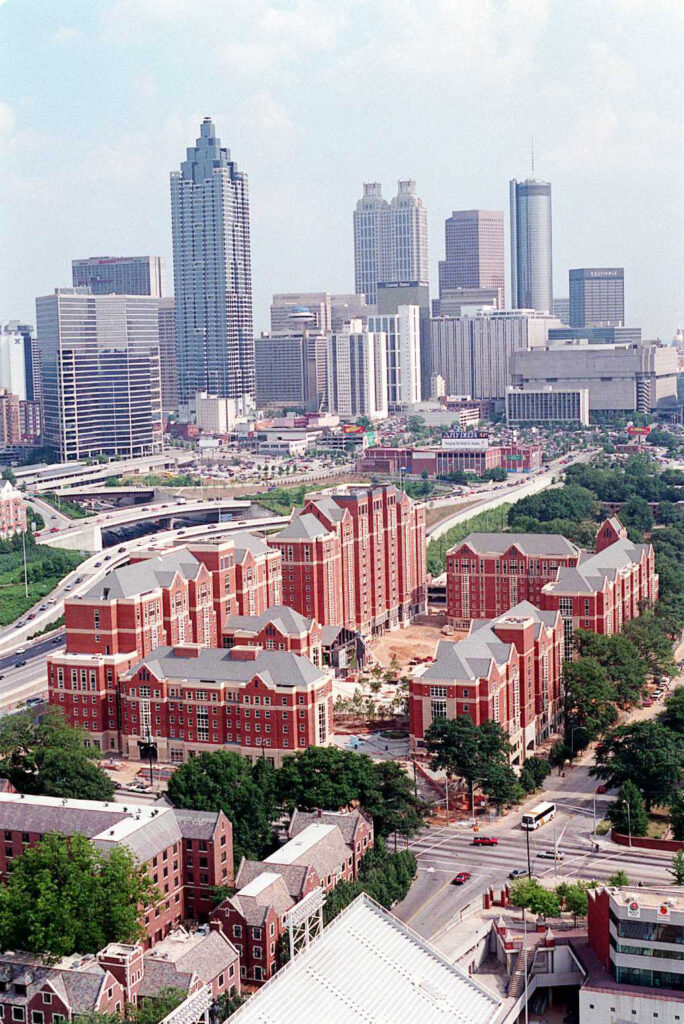
Courtesy of Atlanta Journal-Constitution.
Four major units contribute to the mission: the Advanced Technology Development Center (ATDC), which helps Georgia entrepreneurs launch and build successful technology companies through incubator programs in Savannah, Warner Robins, Columbus, and Atlanta; the Economic Development Institute, which provides technology-driven solutions for Georgia businesses, communities, and economic developers through a statewide network of sixteen regional offices; Georgia Tech VentureLab, which helps faculty and students commercialize the technology they develop, working in tandem with Georgia Tech’s Office of Technology Licensing; and Georgia Tech’s Strategic Corporate Partners, which builds relationships with industrial companies, marketing intellectual property developed at Georgia Tech, and facilitating industrial research and collaborations.
External investment in technology companies assisted by the ATDC totaled more than $94 million for calendar year 2002. During that year incubator companies generated more than $684 million in revenues and provided more than 4,900 high-tech jobs. Overall, forty-four companies participated in the program. Georgia Tech operates three incubator facilities in Atlanta, along with programs in Columbus, Savannah, and Warner Robins.
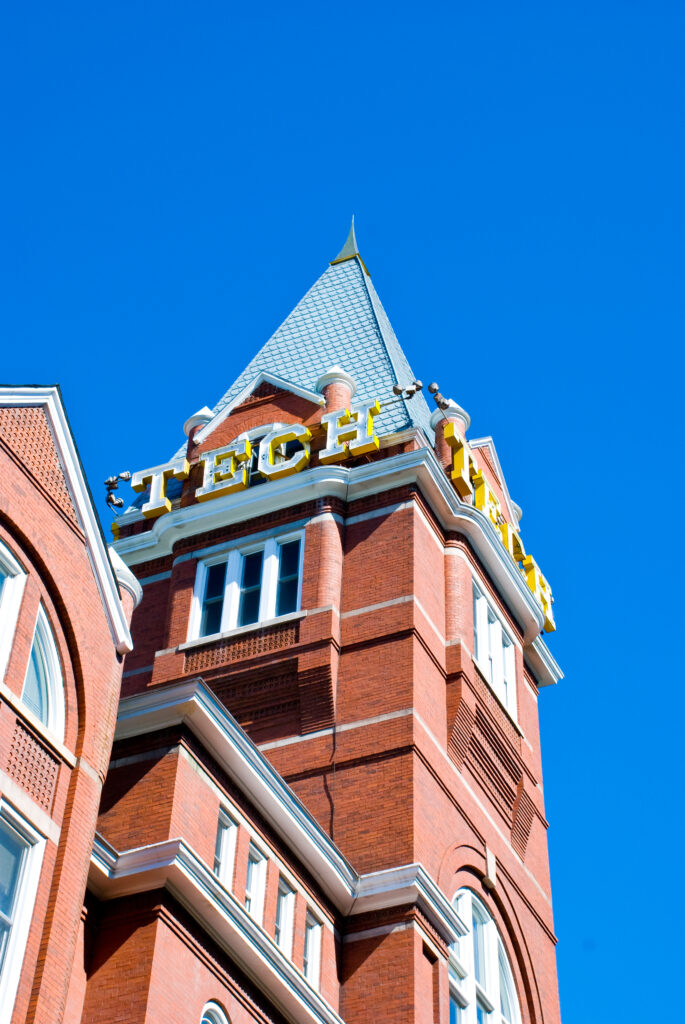
Image from William Brawley
During fiscal year 2003 Georgia Tech’s VentureLab evaluated the commercial potential of forty-five research innovations developed by sixty Georgia Tech faculty. The work brought to 135 the number of technologies evaluated by VentureLab since its formation in 2001. Seven new companies were formed around this Georgia Tech intellectual property during fiscal year 2003, and these new ventures are receiving assistance designed to help them become commercially successful.
Assistance from Georgia Tech’s Economic Development Institute (EDI) to Georgia companies resulted in the creation or retention of 4,536 jobs during 2003. During that same year EDI served 1,649 companies through projects, technical assists, counseling sessions, and information assists. Georgia Tech’s assistance helped companies reduce operating costs by more than $20 million, helping them become more competitive and productive in world markets.
As part of Georgia’s economic development team for prospective or expanding businesses, EDI helped attract more than $41 million in new capital investment and helped create or retain 730 jobs. During fiscal year 2003 the institute assisted 91 Georgia counties in preparing for growth and planning for future economic development, and completed a total of 140 economic development projects for communities, along with 14 economic and fiscal impact analyses for Georgia state agencies.
In 2003 Georgia Tech opened its new Technology Square campus, a $256 million expansion that reconnects its traditional campus to midtown Atlanta across the Interstate 75/85 Downtown Connector. A dramatic demonstration of public-private partnerships, Technology Square houses the Dupree College of Management, Global Learning Conference Center, Economic Development Institute, Advanced Technology Development Center, Barnes and Noble Bookstore, and Georgia Tech Hotel. The new Technology Square Research Building hosts several research groups, including the Georgia Electronic Design Center.
A study conducted in 2003 showed that Georgia Tech graduates make a large contribution to Georgia’s economy. The earning power of the 5,472 Georgia residents who graduated from Georgia Tech between 1993 and 1997 added $102 million in economic impact to the state, reflecting an average salary of more than $46,000 for recent graduates. In 2004 Georgia Tech’s annual budget totaled $729 million.






